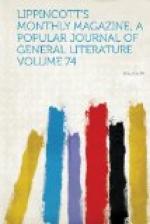A nodule of amygdaloid, a coarse pebble enveloped in a whitish semi-crystalline paste, lies on the table before me. I know that a blow of the hammer will reveal the beauties of its crystal interior, but I do not crush it. It is more to me as it is—more than a letter plucked from the stone pages of time. Coarse and plain, it is an index to a chapter of life. In the occupations of a busy existence we forget how much we owe to the sweet emotional nature which, by mere chance association, retains the dearer part of the past fixed in memory, just as the graceful volutes of a fossil shell are preserved in the coarse matrix of a stony paste. In this way the nodule connects itself with my emotional life, and recalls the incidents of this sketch.
We were journeying over the mountains in the autumn of 1869. Our camp was pitched in a valley of the ascending ridges of the Cumberland range, on the south-east border of Kentucky. At this point the interior valley forms the letter J, the road following the bend, and ascending at the foot of the perpendicular.
It is nearly an hour since sunset, but the twilight still lingers in softened radiance, mellowing the mountain-scenery. The camp-wagons are drawn up on a low pebbly shelf at the foot of the hills, and the kindled fire has set a great carbuncle in the standing pool. A spring branch oozes out of the rocky turf, and flows down to meet a shallow river fretting over shoals. The road we have followed hangs like a rope-ladder from the top of the hills, sagging down in the irregularities till it reaches the river-bed, where it flies apart in strands of sand. The twilight leans upon the opposite ridge, painting its undulations in inconceivably delicate shades of subdued color. Although the night is coming on, the clear-obscure of that dusk, like a limpid pool, reveals all beneath. A road ascending the southern hill cuts through a loamy crust a yellow line, which creeps upward, winding in and out, till nothing is seen of it but a break in the trees set clear against the sky. No art of engineer wrought these graceful bends: it is a wild mountain-pass, followed by the unwieldy buffalo in search of pasturage. Beyond, the mountain rises again precipitously, a ragged tree clinging here and there to the craggy shelves. Around and through the foliage, like a ribbon, the road winds to the top. A blue vapor covers it and the hills melting softly in the distance. At the base of the hills a little river winds and bends to the west through a low fertile bottom, the stem of the J, which is perhaps a mile in width. It turns again, its course marked by a growth of low water-oaks and beeches, following the irregular fold in the hills which has been described.
Leaning against the bluffs hard by the camp is a low white cottage, with its paddock and pinfold, and the cattle are coming up, with bells toning irregularly as they feed and loiter on the way. The supper-horn sends forth a hoarse but mellow fugue in swells and cadences from the farm-house. Over all this sweet rural scene of mountain, valley, river and farm, and over the picturesque camp, with stock, tent and wagons, now brightened by the grace of a young girl, the twilight lingers like love over a home. As I listen and look a soft voice from the carriage at my side says, “Is the ground damp? May I get out?”




